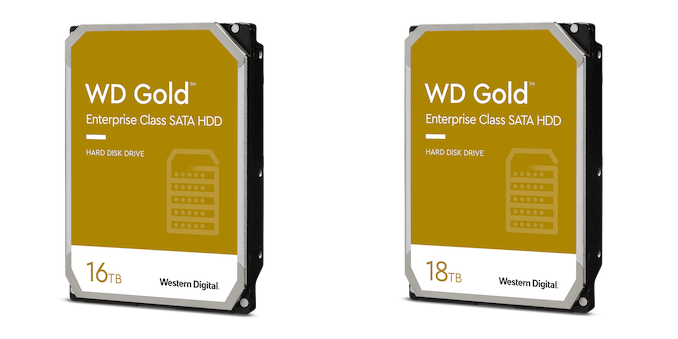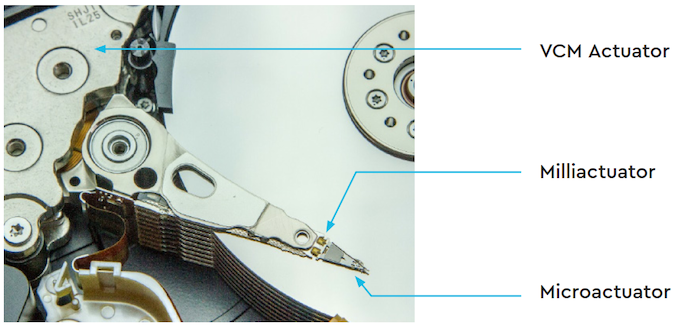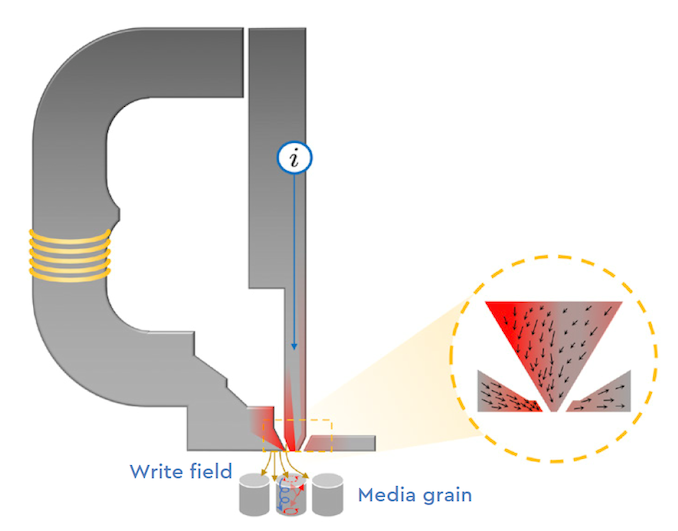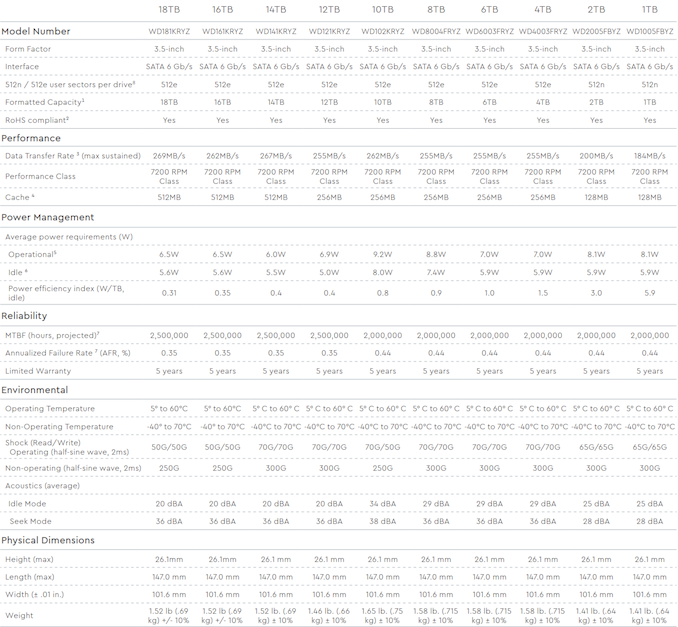Western Digital's 16TB and 18TB Gold Drives: EAMR HDDs Enter the Retail Channel
by Ganesh T S on July 9, 2020 8:00 AM EST- Posted in
- Storage
- HDDs
- NAS
- Western Digital
- MAMR
- Helium HDD
- HAMR
- CMR
- EAMR

Western Digital made a number of announcements yesterday related to their enterprise hard-disk drives (HDD) product lines. While there was nothing unexpected in terms of the products being announced, two aspects stood out - one was the retail availability of EAMR (energy-assisted magnetic recording) HDDs, and the other was additional information on the EAMR technology itself. In 2019, WD had announced the sampling of EAMR-based Ultrastar DC datacenter HDDs with 18TB and 20TB capacities. Yesterday's announcements build upon those products - the WD Gold-branded version of the Ultrastar DC CMR drives is now available for retail purchase, and the Ultrastar drives themselves have moved to general availability. The Ultrastar JBOD and storage server product lines have also been updated to utilize these new high-capacity drives.
Flash-based storage devices have taken over traditional consumer hard-drive application areas. However, increasing data storage requirements mean that HDDs still continue to be the most cost-effective solution for bulk storage. HDD vendors have been working on increasing hard drive capacities using multiple techniques. Around 10 years back, we had 2TB 3.5" HDDs with five PMR (perpendicular magnetic recording) platters in an air-filled enclosure. These drives were CMR (conventional magnetic recording) drives. In the last decade, we have seen advancements in three different categories that have enabled a 10-fold increase in the capacity of HDDs while retaining the same physical footprint:
Increasing the number of platters / making the platters thinner has been made possible by using sealed helium-filled enclosures. The reduced turbulence enables platters to be stacked closer to each other. The first-generation helium HDDs had 7 platters, and this has now grown to 9 platters for the new high-capacity drives.
The size of the writing head and the flexibility with which it can be manipulated dictate the minimum width of the recording tracks on the platters. Western Digital is claiming that they are the first to use a triple-stage actuator (TSA) in shipping HDDs.

The enhanced precision with TSA allows the TPI factor to go up. Incidentally, Seagate also has a novel actuator scheme (dual actuator), though that is aimed at increasing the throughput / IOPS.
One of the key challenges faced in the quest to increase the areal density of platters is the ability of the writing head to reliably alter the magnetic state of the grains in the tracks. Both heat-assisted magnetic recording (HAMR) and microwave-assisted magnetic recording (MAMR) are techniques that address this issue. In 2017, WD seemed set to go all-in on MAMR for their HDD product line, but three years down the road, we are looking at a variant that WD claims is a product of their HAMR and MAMR research - EAMR (energy-assisted magnetic recording).
While details were scant when EAMR was announced , WD is finally opening up on some of the technical aspects.

WD's first-generation EAMR technology (christened as ePMR) involves the application of electrical current to the writing head's main pole (this is in addition to the current sent through the voice coil) during write operations. The additional magnetic field created by this bias current ensures that the bits on the track alter their state in a more deterministic manner. In turn, this allows the bits to be packed closer together and increasing the areal density.
The above techniques can also be used with shingled magnetic recording (SMR) to boost areal density further. SMR has been around in both host-managed and drive-managed versions for a few years now. WD indicated in yesterday's announcement that qualification shipments of their 20TB Ultrastar DC host-managed SMR drive are in progress.

The WD Gold 18TB is available for purchase today and will set you back by $593. The 16TB version is priced at $528, but is currently out of stock. As is typical for enterprise drives, the two new models each have a MTBF of 2.5M hours, workload rating of 550TB/yr, and a 5 year warranty.
Source: Western Digital










69 Comments
View All Comments
FunBunny2 - Saturday, July 11, 2020 - link
"each individual HDD will have to bear a greater proportion of capital, ongoing, and research expense. "the Tyranny of Average Cost at work. same reason a Ferrari cost more than Yugo.
ZoZo - Thursday, July 9, 2020 - link
That's like the opposite of my observations. The decline stopped in 2011 after the floods in Thailand lead to a very severe shortage. Prices shot straight up at that time, and it took years to get the TB/$ ratio back to 2011 levels, probably not before 2016. Much higher capacities had been introduced in the meantime, but at pricing tiers that just did not exist before.Kvaern1 - Saturday, July 11, 2020 - link
"A quick search turned up info up to 2017. It seems cost per TB almost stopped dropping around 2017, but there was a big decline 2009 - 2017."2017 was the year of the Thailand flood. Apparently that was good for business.
ksgtjxBAbK - Thursday, July 9, 2020 - link
Looking back through our PO's (ain't QuickBooks great!) I found an order for 2TB WD enterprise drives dated ten years and ten days ago. $249 each. With bulk discounts. A 9x capacity increase for a 2x price increase (given $250 in 2010 ~= $300 today) is not bad.ZoZo - Thursday, July 9, 2020 - link
10 years ago, non-enterprise ones cost $100 in online stores.DanNeely - Friday, July 10, 2020 - link
10 years ago they sold 10x as many non-enterprise drives. The collapse in sales volume and reduced economies of scale has hammered low margin consumer models far harder than enterprise ones.s.yu - Saturday, July 11, 2020 - link
Then their margins are higher, at the cost of consumers of course.crimsonson - Thursday, July 9, 2020 - link
Yea - the OP is making comments on something that was not mentioned in the quote. Puzzling.MrVibrato - Thursday, July 9, 2020 - link
I guess azfacea refers to the actual WD press release (linked at the end of the article), which talks about TCO...name99 - Thursday, July 9, 2020 - link
WD say nothing about exact costs, like whether they have dropped by 10x or whatever.What they say is the new drives offre "unmatched total cost of ownership".
Is that a reasonable claim? Why not?
You CAN find cheaper cost per bit for example you can get a (slower...) 12TB drive right now for around $220. But the claim is not cheaper cost per bit, it's TCO.
(a) For COMPARABLE drives, so also enterprise class, cost per bit is close to the same, say around $330 for 12TB.
(b) More importantly you have to pay for using these drives in physical space (ie rent), in AC cooling costs, in electricity. Maybe these drives are even more reliable than their predecessors.
Without knowing these numbers we have no way to say whether TCO is lower or not.
But I'm going to trust WD on this more than some rando on the internet who's upset at something the rest of us cannot see or understand.